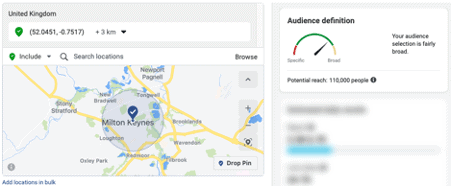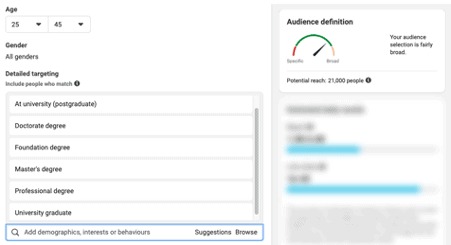Let’s take this research and apply it to our theoretical pizza restaurant in Milton Keynes to see how we can refine the target audience of a Facebook Ad campaign to be most effective.
We want to display our advertisement for four days, through a ‘traffic’ campaign, meaning we will be sending visitors (traffic) to our website.
The estimated reach of the default geographic region of Milton Keynes and surrounding area (17km) is an estimated 380,000 people. Facebook estimates a £100 budget would reach around 2,500 people per day, or a little under 1% of the region’s Facebook users.
Let’s plug our market segmentation research into a campaign and see how this affects things.
Geographic Region Limitation
By limiting the area to just 2 miles from our restaurant we bring our target audience down by over two-thirds to 110,000 people.

Demographics
Next we’ll define the age bracket of our prime audience to 25-45 years old, now we half the potential audience to 58,000.
As we want to target people with a higher income, we are going to aim at people with a degree as their minimum qualification, bringing our potential audience down to 24,000, one-sixth of the original figure.

Psychographics – Interests
Narrowing this down further, we can target Facebook users who have expressed an interest in Food and Drink, specifically Fast casual restaurants and Diners, and Food – with the subcategory of Pizza.
Add to that theatre goers and our potential audience is now down to 12,000 people, which is over 35 times more specific than when we started.

Behavioural
Facebook doesn’t give too many options for behaviour, so we’re going to select Engaged Shoppers. This means that we are going to target people who have recently clicked on a Shop Now / Buy Now button on a Facebook business page, bringing the total down to 5,900 people.

Excluding Specific Groups
What about the things that we don’t want to include? From the demographics we can exclude Commuters to bring it down further to 5,300.
Facebook prevents us from targeting some criteria discriminating against people for their life choices. This includes religion, ability to target vegans, amongst others.
Conclusion
We are now down to 5,300 as our specified target audience – much more targeted than the 380,000 we had to start with. In fact we have narrowed it down to just 1.5% of people we consider our campaign relevant to.
Consider the impact that this will have on your ad spend – to reach 380,000 people over a four day campaign would have cost in excess of £10,000. To send out to 5,300 people – who we have identified as having the highest intent of buying, will only cost £70.
Recouping the ad investment and turning it into a profitable campaign is now a much more realistic option as we are able to target people we know will have a higher interest in buying.
By considering the psychographic, demographic, geographic and behavioural traits of your customers, you will be able to define a high quality target audience over a large quantity generic audience, which is crucial to help ensure your marketing efforts are successful.